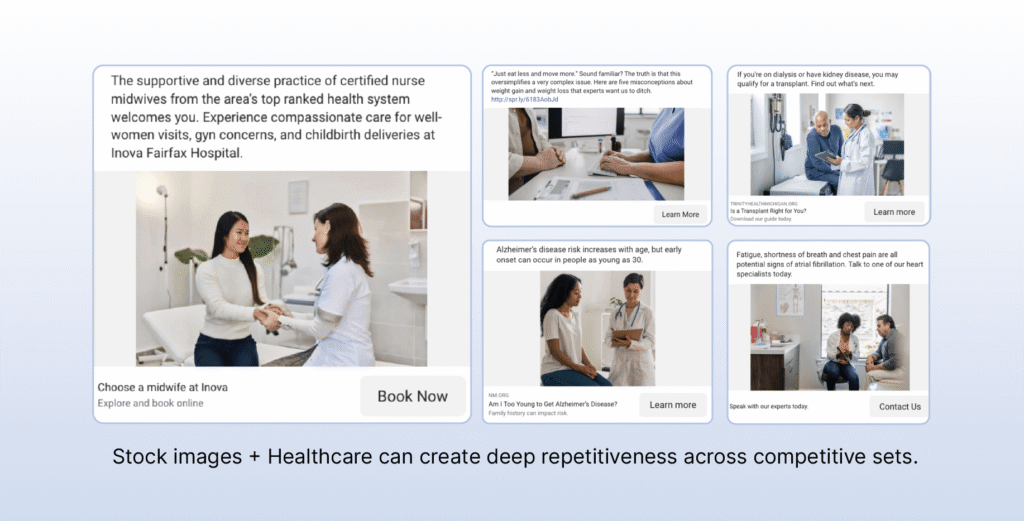The advertising landscape shifted under healthcare marketers’ feet this year as Meta’s Andromeda update fundamentally changed how the platform delivers ads to users. While precise audience targeting remains available, Meta is aggressively pushing advertisers toward creative signal-based delivery through Advantage+ campaigns. The platform now prioritizes creative signals over traditional demographic and interest-based targeting to determine who sees your ads.
Table of Contents
This strategic shift presents both opportunity and challenge for healthcare advertisers. Automation can boost efficiency and help you reach new qualified audiences, but only if you feed the algorithm the right ingredients: diverse, high-quality creative assets and compliant conversion signals.
From targeting controls to creative signals
Meta’s Andromeda represents a seismic shift in how the platform operates. The system now processes billions of creative-audience interactions to learn what messages, tones, and visuals resonate with different user types. Rather than marketers defining audiences upfront, Meta infers them from the creative content itself.
“Meta is using creative signals rather than audience targeting to inform who sees your ad,” explained Jean Zhang, Senior Creative Director at Cardinal, during Scaling Up: The Healthcare Performance Marketing Summit. “Making creative variety the new targeting strategy.”
This transformation makes Advantage+ campaigns smarter but less transparent. The system increasingly manages audience expansion, placement, and delivery automatically. For healthcare marketers accustomed to granular targeting controls, this requires a fundamental mindset shift. Success now depends on two critical factors: the quality of your creative content and the integrity of your conversion data.
The change reflects Meta’s move toward full-funnel automation. While traditional audience targeting remains available, creative diversity and signal quality are becoming the primary performance levers for advertisers choosing Advantage+ campaigns. Healthcare groups must decide whether to continue with detailed demographic filters and interest-based targeting or embrace Meta’s automated approach that prioritizes creative signals over manual audience definition.
The healthcare privacy challenge
Healthcare advertisers face a unique predicament with Andromeda’s data requirements. HIPAA restrictions and Meta’s 2025 CAPI policy changes limit the transmission of patient-identifying information back to the platform. Without proper conversion signals, Meta’s algorithm struggles to learn what constitutes a qualified lead.
Many health systems have reduced or paused CAPI usage until compliant data-passback solutions are implemented. The result includes:
- Higher acquisition costs as algorithms optimize without conversion feedback
- Wasted ad spend on unqualified prospects
- Reduced campaign efficiency across all Meta advertising efforts
- Inability to scale successful campaign elements
This creates what we call the “creative and signal dual dependency.” Zhang emphasized that “the competitive advantage now lies in feeding the platform diverse, high-quality creative” while establishing consistent conversion feedback loops. Creative alone won’t suffice if Meta can’t learn which personas and value propositions drive real patient outcomes.
The solution requires building privacy-safe infrastructure that captures meaningful conversion events without exposing protected health information. This might include HIPAA-compliant call tracking systems, secure CRM integrations, and carefully configured server-side data connections that transmit aggregated, de-identified conversion data back to Meta.
Platform-native funnel strategies
Lisa Fisher, Associate Media Director at Cardinal, advocates for a different approach that keeps everything within Meta’s ecosystem.
“We can foster engagement and nurture leads within Meta, keeping them in the ecosystem so we can retarget based on their interactions,” she explained during a recent Ignite Healthcare Marketing podcast episode.
This strategy leverages in-platform engagement signals as proxy conversions:
- Video completion rates (50% viewing threshold indicates genuine interest)
- Instant experience interactions (mini landing pages within Meta)
- Lead form submissions (direct capture without external tracking)
- Quiz participation (interactive engagement measurement)
- Social engagement metrics (shares, comments, saves)
Platform-native funnels work particularly well for healthcare groups restricted by HIPAA compliance requirements. For example, video viewers who complete 50% or more of content demonstrate genuine interest without requiring external tracking. Instant experience engagements provide rich behavioral data while keeping users within Meta’s controlled environment.

These native signals serve as training data for Andromeda’s algorithm. Over time, the system learns to identify high-intent users based on their in-platform behaviors, enabling effective retargeting and audience expansion without direct conversion tracking.
Creative diversity as a competitive advantage
Meta’s Andromeda represents a fundamental shift in how healthcare marketers should approach creative development.
As Zhang explains, “Meta is using creative signals rather than audience targeting to inform who sees your ad, making creative variety the new targeting strategy.”
This change requires healthcare organizations to move beyond traditional testing methods. Your creative portfolio should span multiple personas, message themes, and content formats.
For instance, patient success stories resonate with prospective patients seeking social proof. Provider credibility pieces build trust with users researching qualifications. Service-specific content addresses distinct treatment concerns. Meta’s AI analyzes performance patterns across these varied assets to determine which messages work best for different audience types.
Zhang has developed systematic creative testing frameworks that align with how Andromeda learns. Cardinal’s creative team iterates around value propositions, formats, and emotional appeals to provide the algorithm with rich training data. “You can’t ask someone to marry you on the second date,” Zhang notes, emphasizing the importance of funnel-appropriate messaging that matches where patients are in their decision-making journey.

Andromeda rewards creative variety above all else. The more creative options healthcare marketers provide, the better Meta can personalize ad delivery to different user segments.
Essential Creative Portfolio Elements
A high-performing Meta patient acquisition strategy now depends on creative variety. These are the five core asset types every healthcare advertiser needs in their portfolio.
Persona-Focused Creative
Tailored visuals and messages built around distinct motivations, barriers, and needs. Meta learns faster when each persona has its own creative path.
Proof-Driven Value Propositions
Specific claims with evidence, such as technology, outcomes, certifications, treatment approaches, and insurance accepted. Avoid vague statements that blend into the “sea of sameness.”
Journey-Aligned Assets (TOF / MOF / BOF)
- TOF: resource-led videos, explainers, testimonials
- MOF: differentiators, provider credibility, treatment approach
- BOF: direct CTAs, insurance, scheduling, friction-reducing details
Emotional + Fact-Based Variants
Our testing showed that both emotional support messages and fact-heavy messages can earn patient engagement, but it depends on the persona. Include both so Meta can learn.
Modular Creative Sets
Bundles of variations around the same idea (different tones, visuals, and formats) to feed consistent testing and iteration.
A structured testing system turns creative variety into real insight. When those learnings flow back into new assets, Andromeda can optimize faster and push your best messages further.
Next steps for adapting to Andromeda
1. Strengthen your data and tracking foundation
Start by auditing your Meta setup, Business Manager configuration, and measurement infrastructure. Identify where tracking degrades under new CAPI and HIPAA constraints, and determine where first-party or modeled data can safely flow back to Meta. Even partial signal improvements help Andromeda learn faster.
Key actions:
- Validate CAPI signal quality and event prioritization
- Confirm HIPAA-compliant pathways for modeled or aggregated data
- Remove orphaned, redundant, or non-functional events
A clean data foundation won’t solve everything, but without it, Andromeda has nothing reliable to work from.
2. Build full-funnel, platform-native patient journeys
Andromeda rewards advertisers who keep people inside Meta’s ecosystem. Create engagement paths that warm audiences natively before they ever touch a landing page.
This includes using:
- Engagement objectives that build intent signals
- Instant Experiences that function as mini landing pages
- Lead forms and conditional questions to pre-qualify interest
- Short-form content and interactive formats that encourage micro-engagement
This full-funnel structure gives Meta more behavioral signals to optimize delivery, which is especially critical when external tracking is limited.
3. Adopt persona-based creative mapping
Creative testing can no longer rely on small A/B variations. Andromeda learns best when advertisers offer distinct creative concepts tied to real patient motivations, barriers, and service lines.
What to deploy:
- Multiple angles for each persona (proof-based, emotional, value prop–driven)
- Creative aligned to the patient journey (TOF → MOF → BOF)
- Variations in tone, visual style, and messaging—not micro tweaks
This approach mirrors how Meta’s models evaluate creative signals and dramatically improves relevance and efficiency.
4. Align media, creative, and analytics around performance feedback
Andromeda places more weight than ever on continuous learning. Your teams must operate as a single loop—not silos—to interpret performance and turn insights into new creative inputs.
Cross-functional alignment should include:
- Analytics surfacing persona-level performance patterns
- Media identifying where engagement signals strengthen or weaken
- Creative rapidly producing new assets based on these learnings
This collaboration is what actually “trains” Andromeda over time on what creative works best.
5. Modernize your measurement approach
Privacy constraints make last-click attribution unreliable—and in some cases, noncompliant. To understand Meta’s contribution to patient acquisition, healthcare marketers need measurement frameworks that work without user-level precision.
Recommended methods:
- Media mix modeling (MMM) for higher-level budget and channel planning
- Incrementality testing to quantify Meta’s net-new patient lift
- Geo-based experiments when appropriate
This approach helps teams calibrate expectations and make smart investment decisions while respecting HIPAA.
Meta’s GEM update: The next layer of automation
Another step in Meta’s automation evolution is the Generative Ads Model (GEM), introduced earlier in 2025. GEM is a large-scale foundation model trained on thousands of GPUs that improves how Meta’s ad system predicts and ranks which ads to show across Facebook and Instagram. It learns from cross-surface behavior and creative performance, boosting conversion rates through more relevant ad delivery.
- GEM = the “central brain” that orchestrates the full ads ecosystem.
- Andromeda = the retrieval engine that surfaces the most relevant ad candidates.
In Meta’s November 10 update, the company reported: “Since launching GEM earlier this year, GEM’s launch across Facebook and Instagram has delivered a 5% increase in ad conversions on Instagram and a 3% increase in ad conversions on Facebook Feed in Q2.”
Together, GEM and Andromeda reinforce the same takeaway: Healthcare marketers need deep persona understanding and a high volume of creative variation for Meta’s models to optimize effectively.

